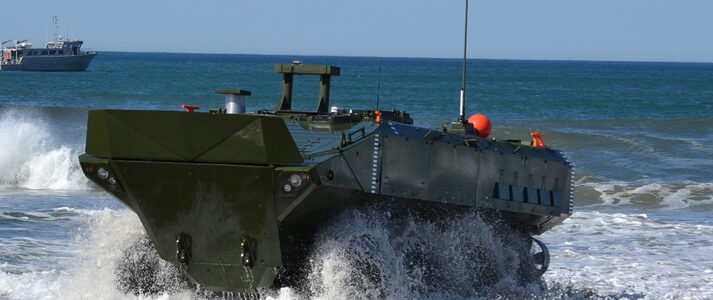BAE Systems has been a trusted supplier to the US Marine Corps for more than 70 years. Their most recent engineering accomplishment is the next-gen ACV 1.1 Amphibious Combat Vehicle. Set to replace the current range of Amphibious Assault Vehicles (AAVs), the new vehicle offers improved survivability.
This particular combat vehicle was designed from scratch to meet the real mission challenges of deploying Marines from ship to shore. The ACV 1.1 is a combination of the long history between BAE Systems’ amphibious legacy and Iveco Defence Vehicles’. Together, they have produced more than 30 000 multi-purpose armoured vehicles with the latest variant a certain standout.
From Prototype To Combat-Ready
BAE Systems carried out their own in-house risk assessments and evaluation for land mobility, survivability, and swim capabilities before even delivering their first 16 prototypes. Using an existing, combat-proven design helped them develop a unique prototype. Unlike some of its predecessors, the ACV 1.1 was designed and developed as an amphibious vehicle from the onset. Judging from all the features, design quality and capabilities, this combat vehicle is a welcome addition to the armed forces.
The primary goal of this project is enabling US Marines to act as the infantry arm of the US Navy. This necessitated the development of a fully amphibious combat vehicle with advanced capabilities to complete its mission. The ACV 1.1 program aims at providing Marines with a high-speed armoured vehicle capable of self-deploying and fully operational in open seas and also combat on land accompanying the M1A1 Abrams front-line battle tank.
It has greater ship-to-shore capability than any similar combat vehicle in the world. BAE has already completed several sea demonstrations including operating in Sea State 3 conditions. During the tests, the ACV proved its ability to perform ship launch and recovery which is an essential requirement of the program.
Amphibious Combat Vehicle Specifications
In terms of structure and design, the ACV 1.1 has a V-shaped, blast-resistant hull specially designed to protect against mines and IEDs. It can carry 13 Marines and the suspended interior seat structure adds a new element of troop safety against kinetic energy rounds and overhead blasts. Additionally, the three-man crew have their own blast protection along with a fire suppression system.
Equipped with a six-cylinder 690 HP engine, it provides significantly more power than the current Assault Amphibious Vehicle (AAV). The range on land is also impressive at more than 325 miles and capable of reaching speeds exceeding 65 Mph. At sea, the ACV can reach 6 knots (7 Mph or 11 km/h) and travel 12 nm (13 miles or 22 km). Sea and land performance are important for the Marines to execute missions quickly, effectively and as safe as possible.
The robust 8×8 platform offers true open-ocean amphibious capability, land mobility, survivability, payload, and growth potential. Fitted with two propellers at the back for thrust, a simple push of a button switches between land and swim mode. At the front, a bow plane is deployed along with a snorkel for air intake to cool the engine when going into swim mode. They also fitted a cooling box on the starboard side to allow water in for additional cooling of the engine.
There are 4 wheels on each side of the ACV and with the H-drive, there are no axles. Each wheel attaches to a drive box which connects to a driveshaft. In fact, the vehicle has three driveshafts which connects to a transfer box in the middle of the vehicle. The primary purpose here is to improve mobility in soft soil environments similarly to a tracked vehicle.
Final Thoughts On The New Amphibious Combat Vehicle
Regardless of nation, location or ideals, security threats are a real concern on a global scale. The new ACV is leading from the front in terms of troop safety, mobility and manoeuvrability. This versatile combat vehicle can accommodate growth for future technologies or requirements. It can also accommodate a wide range of direct and indirect fire weapon systems.
According to Col. Wendell Leimbach, the Advanced Amphibious Assault program manager, “The ACV will bring a modern, wheeled capability that has landward mobility on par with a modern battle tank along with the remarkable survivability that the system has for underbody blasts and also other threats.”
The new ACV has demonstrated and proved to be a game-changer in the amphibious combat vehicle segment. It will allow the Marine Corps to operate across all mission profiles, including extremes with surf and the open ocean. What are your thoughts on the new ACV 1.1?
At PRV Engineering, we have worked with the defence industry for more than six years. Tasked with developing armour plated products for the outside of military vehicles, mounts for internal equipment, electronics and exterior mounts. We are also involved with innovative new developments such as busbars for carrying power and data within vehicles. Visit our website for more information and get in touch if you need help with your engineering project.


Recent Comments